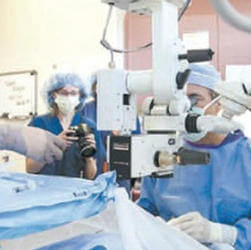Local doctors return sight to needy patients

Several low-income and uninsured Santa Barbara patients saw the light Saturday morning, thanks to the work of three local eye surgeons, two anesthesiologists and their teams of dedicated volunteers.
Cataract Day was a collaboration between humanitarian nonprofit SEE International and the Santa Barbara Surgery Center.
One by one, seven grateful patients left the surgery center with the ability to see again, the clouding removed from their eyes, their lives enhanced.
“They can function again. Their families are freed up,” said Dr. Michael Paveloff.
Due to the severity of their cataracts, the patients seen on Saturday, were considered legally blind, he said.
The surgeries took between 15 and 30 minutes each, with surgeons carefully removing the cataract-clouded lenses and replacing them with artificial ones. Recovery time is brief, said Dr. Paveloff, with patients generally up and about within days.
Saturday’s surgeries are part of SEE International’s local outreach. Originally established and more typically known for the humanitarian missions it conducts in places like Africa and Asia, the organization turned its attention to more local issues, and the sight and vision needs of local residents.
Through a program called the Santa Barbara Vision care program, SEE collaborates with local partners, including Santa Barbara Eyeglass Factory, and in this case the Santa Barbara Surgery Center, to provide services to local patients.
What many of the patients had in common for Cataract Day, besides their eye conditions, was the fact that they were also too young to qualify for Medicare, despite the fact that cataracts are more typically known as a condition of the elderly.
All the more reason, said Dr. Paveloff, to restore their vision so they can get back to work and taking care of their families. “They can get back to 20/20 vision,” he said.
The ability to distinguish colors improves, as well. While a condition that is virtually inevitable with age, cataracts can also be the results of diabetes, poor nutrition, corticosteroid use, even trauma.
Cataracts are the major cause of blindness worldwide and the condition is prevalent in more sun-exposed countries, including those in Africa and South America, and the tropics of Asia, where excessive UV exposure is the major cause of the condition. Despite the many expeditions and thousand of surgeries SEE has performed worldwide each year, according to SEE Board Member Dr. George Primbs, the need continues to outweigh the organization’s ability to meet it.
Cataract Day at the Santa Barbara Surgery Center was also a chance to give back to Santa Barbara, said Dr. Gary Anderson, one of the volunteer anesthesiologists and Medical Director of the Surgery Center.
He was encouraged by the turnout of the Surgery Center staff who freely gave their Saturday morning to help others see again.
“It does my heart good to see people asking themselves, “What can I do to make this a better community?”

